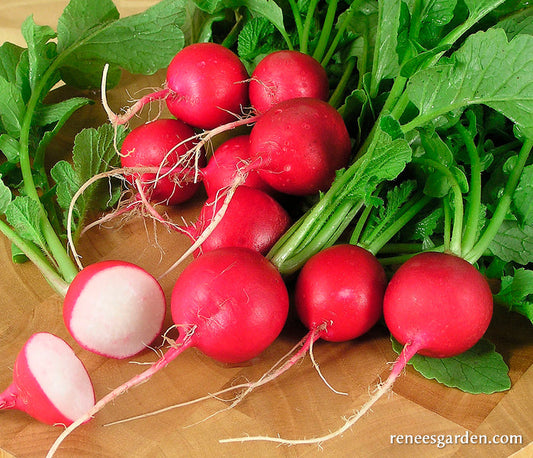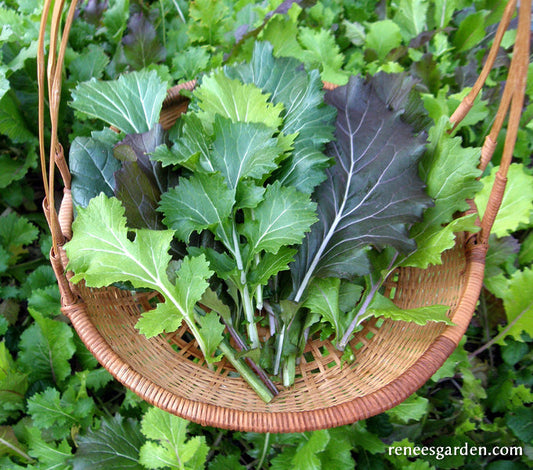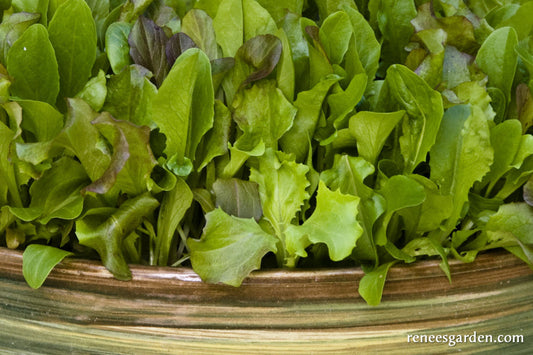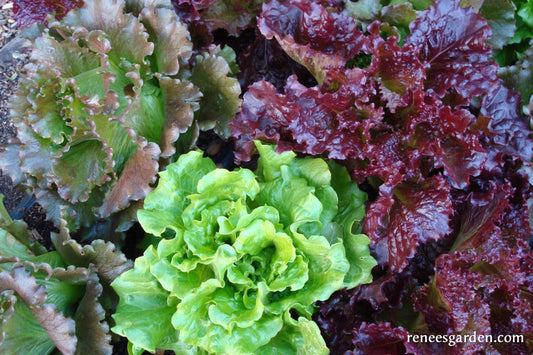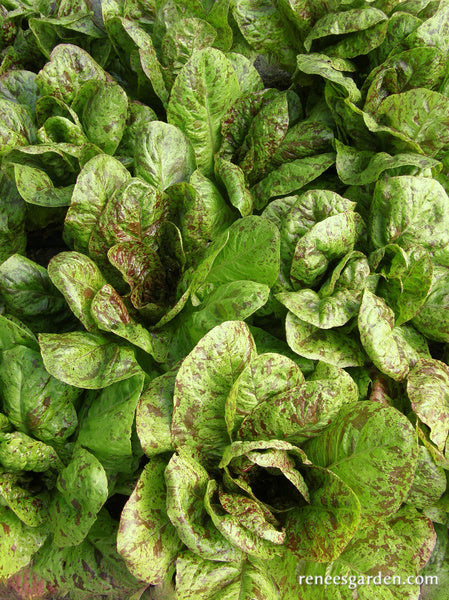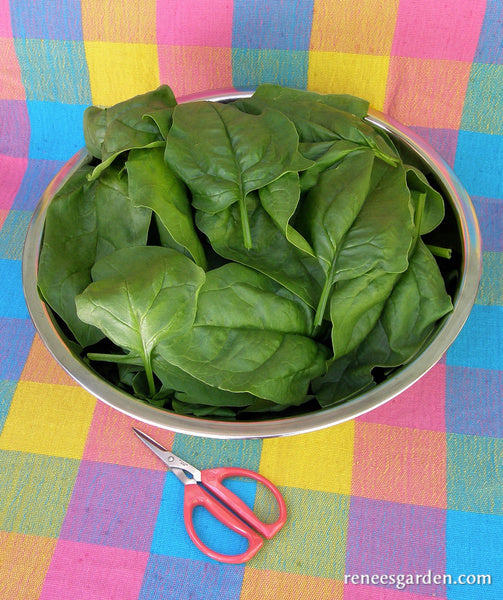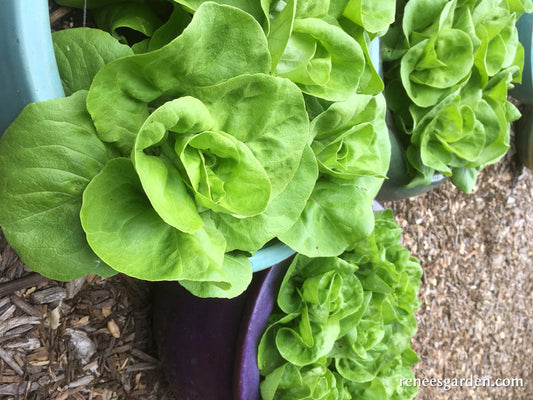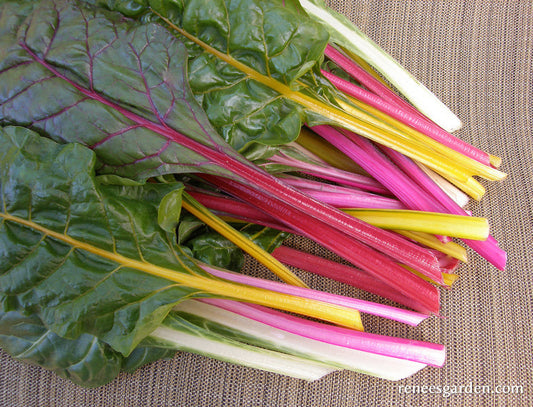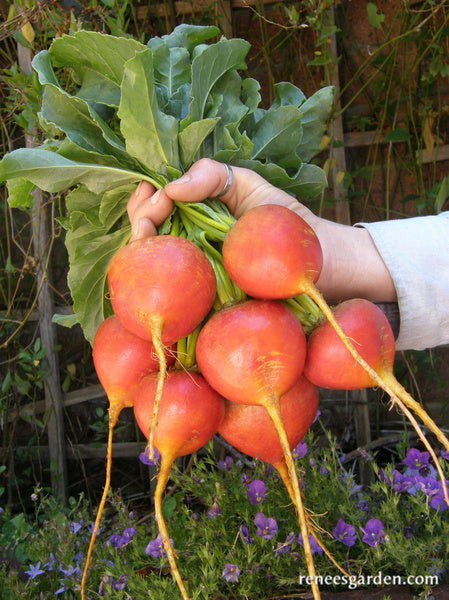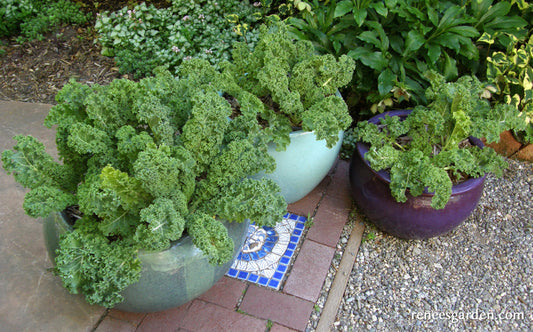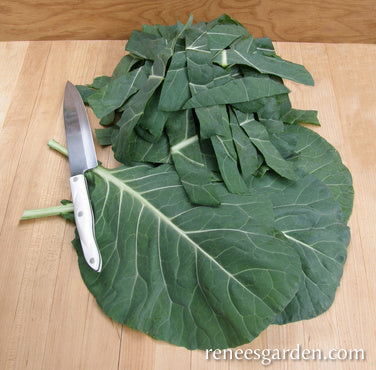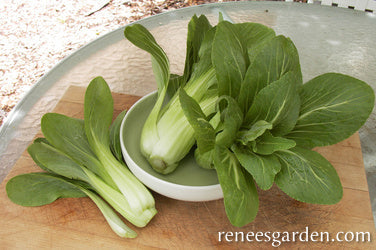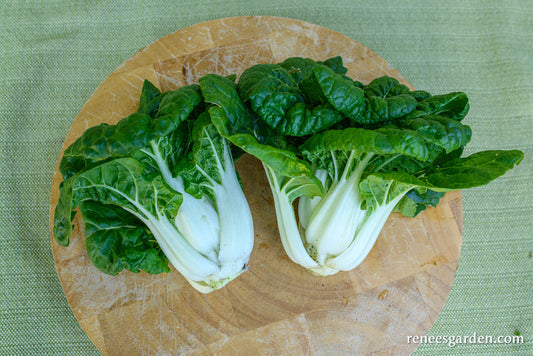Cool Weather Vegetables and Herbs
Easy to grow, highly nutritious and great tasting, these favorite early spring vegetables love cool weather and are the first varieties you can direct sow in the garden. If you live in colder climates, sow as soon as the danger of frost has passed. Fast-growing for earliest harvests, you'll find complete planting instructions on every packet and on our website.
-
Lawn & Patio Collards Georgia Southern Seeds
Large plants up to 4 feet tall have blue-green, succulent leaves with a mild, cabbage-like flavor. Traditional Southern dish served with pork and black-eyed peas.Regular price $2.29Sale price $2.29Unit price / per -
Round Red Radishes Crimson Crunch
START SEEDS OUTDOORS
In early spring as soon as ground can be worked, sow radish seeds in well-worked, fertile soil in full sun. Space seeds 1 inch apart in wide rows 6 inches apart. Cover 1/2 inch deep. Keep soil evenly moist and well weeded. If first sowing comes up unevenly, replant right away. Sow in late summer for a fall crop.
GROWING NOTES
Sow this quick growing, cool season crop wherever you intend to plant heat lovers later. Radishes thrive and have crisp flesh and the best mild flavor given consistent moisture. Sow small amounts a week apart to mature in warm but not hot weather. Thin quick-growing seedlings early to 2 inches apart so roots have room to size up. Protect radishes with floating row covers if marauding birds or flea beetles that chew holes in the leaves are a problem.
HARVEST AND USE
Harvest radishes when roots are the size of large marbles. If weather turns unexpectedly hot, pull, cut off tops, and store in the refrigerator for up to 3 weeks. Radishes will be spicier in hot weather and milder grown in cooler conditions. Combine sliced radishes, scallions and fresh dill or parsley for a great salad. Make delicious openfaced sandwiches on whole grain bread spread with sweet butter and topped with sliced radishes.
Regular price $3.99Sale price $3.99Unit price / per -
Signature Salads Crispy Winter Greens
START SEEDS OUTDOORS
At midsummer, or early fall in mild climates, sow seeds in a sunny garden bed 1/4 inch deep and 1 to 2 inches apart in rows 12 inches apart. Or, if it is still over 80°F (27°C) at sowing time, sow seeds in containers in a spot out of direct sun, but with bright light all day. Tend carefully and keep evenly moist. When seedlings are a few inches tall with several sets of leaves, transplant into the garden a foot apart. Gradually thin directly sown seedlings to stand 1 foot apart to allow heads room to mature.
GROWING NOTES
Savor earliest thinnings in fall salads. Cool weather will bring vigorous growth. These tasty greens tolerate cold weather and light frosts well but require consistent moisture. Weed, water and thin carefully and feed monthly for best quality salad heads.
HARVEST AND USE
Radicchio is best harvested when red heads have formed inside the outer green “wrapper” leaves. Pick entire heavy rosettes of escarole and curly endive. Cut up and enjoy these hearty salads with either simple vinaigrettes or rich, creamy dressings. Try tossed with cooked chicken, meat or cubed cheese and olives for delicious whole meal salads. Add toasted nuts and cubed apples or pears for a delicious flavor contrast.
Regular price $3.69Sale price $3.69Unit price / per -
Heirloom Greens Cut & Come Again Mustards
START SEEDS OUTDOORS
In cool early spring weather, sow seeds in finely worked soil in full sun. Shake seeds from the palm of your hand, broadcasting them about 1/2 inch apart over the entire seedbed or in wide rows, and cover lightly and evenly with 1/4 inch of fine soil. Firm soil gently and water with a fine spray. Keep seedbed evenly moist. Make small successive sowings until summer weather turns hot for a constant supply. Plant again in late summer for fall harvesting.
GROWING NOTES
This mix will thrive in mild weather with consistent moisture. To extend the sowing season into hot weather, sow in light shade or erect a canopy of loosely woven shade cloth over the bed. Birds are often attracted to tender young seedlings, so protect them if necessary.
HARVEST AND USE
To harvest by the “cut and come again” method, wait until plants are 4 to 6 inches tall. Cut as much as you need, using scissors to shear off a patch of leaves about 1 to 2 inches above the soil level. Water well and fertilize lightly and plants will regrow for several more cuttings. Sauté leaves quickly in olive oil with a little chopped garlic or steam and finish with a splash of hot sauce or rice vinegar.
Regular price $4.89Sale price $4.89Unit price / per -
Baby Mesclun Lettuces Cut and Come Again
START SEEDS OUTDOORS
In early spring, sow seeds in finely worked soil in full sun. Shake seeds from the palm of your hand, broadcasting them about a half inch apart over the entire seedbed or in wide rows, and cover lightly and evenly with 1/4 inch of fine soil. Firm soil gently and water in with a fine spray. Keep seedbed evenly moist. Make small successive sowings until summer weather turns hot for a constant supply. Plant again in late summer for ample fall harvesting.
GROWING NOTES
This mesclun mix thrives in mild weather with consistent moisture. To extend the sowing season into hot weather, sow in light shade or erect a canopy of loosely woven shade cloth over the seed bed. Birds are often attracted to tender young seedlings so protect them if necessary.
HARVEST AND USE
Begin harvesting by the “cut and come again” method when plants are 4 or 5 inches tall. Cut as much lettuce as you need, using scissors to shear off a patch of leaves 1 to 2 inches above the soil level. Water well and fertilize lightly and plants will regrow for several more cuttings. Dress with a simple vinaigrette to enjoy the sweet flavor and juicy texture of these delicate young leaves at their best.
Regular price $3.39Sale price $3.39Unit price / per -
Salad Scallions Delicious Duo
EASIEST TO START OUTDOORS
Plant scallions throughout the spring and again in mid to late summer for fall harvests. Sow seeds in well-worked, fertile soil in full sun. Space seeds 1 inch apart in rows 8 to 10 inches apart, or broadcast evenly for bed planting. Cover 1/2 inch deep and firm soil well over seeds. Be sure to keep soil evenly moist to ensure good germination.
THIN OR TRANSPLANT
Space 1 to 2 inches apart, allowing plants room to mature.
GROWING NOTES
Scallions take up little garden space, so tuck several rows around beds of lettuce, spinach or radishes. Make several plantings a month apart to have a constant supply for spring and summer meals. Prepare soil well with lots of aged manure or compost before planting. Keep evenly moist and weed carefully when plants are young. Mulching to conserve soil moisture and suppress weed growth is a good strategy.
HARVEST AND USE
To get the most out of your crop, start by using tender, mild-flavored early thinnings in salads, then continue thinning gradually so mature scallions stand an inch or two apart. These colorful scallions are best if harvested at 10 to 12 inches tall or before they send up bloom stalks, which makes the stems turn tough and too spicy.Regular price $3.99Sale price $3.99Unit price / per -
Triple-Curled Kale Dutch Darkibor
TO START DIRECTLY IN THE GARDEN
As soon as ground can be worked in spring, prepare a well-drained, fertile garden bed in full sun. Sow seeds 2 inches apart in rows 12 to 18 inches apart. Cover 1/2 inch deep and keep soil evenly moist to ensure good germination. Sow again in late summer for another cold-hardy crop.
TO START INDOORS
Sow seeds in a container of seed starting mix 2 inches apart and cover 1/2 inch deep. Keep moist and provide a strong light source until seedlings are 3 to 4 inches tall then plant outdoors. Space 10 to 12 inches apart so plants have room to mature.
GROWING NOTES
Kale tastes best in cool weather so sow spring crops early. A crop sown in late summer will yield through fall and winter except in the coldest climates. Frost actually enhances kale leaves’ color, flavor and sweetness. Mulch to retain moisture in summer and before the ground freezes to protect the roots of fall crops.
HARVEST AND USE
Begin harvesting outer leaves when plants have 6 to 8 leaves. Vitamin-rich kale is delicious in hearty winter soups, stews and sautés; or braise the beautiful leaves with garlic and olive oil in traditional Mediterranean style. Pull and discard once plants begin to bloom since the leaves of flowering stalks get tough and bitter.
Regular price $3.99Sale price $3.99Unit price / per -
Gai Lan/Chinese Broccoli Early Jade
START SEEDS DIRECTLY IN THE GARDEN
In very early spring as soon as ground can be worked, prepare a well-drained, fertile garden bed in full sun. Sow seeds 2 inches apart in rows 6 to 8 inches apart. Cover 1/2 inch deep and keep soil evenly moist to ensure good germination. When seedlings are 3 to 4 inches tall, thin to stand 4 to 6 inches apart.
GROWING NOTES
Sow Gai Lan in cool early spring weather, about the same time as you plant turnips and radishes. Consistent moisture, early thinning and an adequate supply of nitrogen will encourage the quick growth needed to produce thick, juicy stalks of leaves and flower buds. Use non-toxic Bt (Bacillus thuringiensis) products to control caterpillar pests as necessary. Make several sowings a week apart for a continuous harvest. Sow again in late summer for a fall crop.
HARVEST AND USE
Harvest both leaves and flowering stalks at 7 to 8 inches tall, when stalks are still tender. After cutting, water plants and feed with fish emulsion solution to get a second harvest in a few weeks.
Enjoy the broccoli-like flavor of vitamin-rich Gai Lan by quickly stirfrying with ginger and garlic. Oyster or black bean sauce and a spritz of toasted sesame oil and hot sauce are other tasty additions..
Regular price $3.69Sale price $3.69Unit price / perNew -
Rainbow Radishes Easter Egg II
START SEEDS OUTDOORS
In early spring as soon as ground can be worked, sow radish seeds in well-worked, fertile soil in full sun. Space seeds 1 inch apart in wide rows 6 inches apart. Keep soil evenly moist and well weeded. If first sowing comes up unevenly, replant right away. Sow in late summer for a fall crop.
GROWING NOTES
Sow this quick growing, cool season crop wherever you intend to plant heat lovers later. Radishes thrive and have crisp flesh and the best mild flavor given consistent moisture. Sow small amounts a week apart to mature before or after summer heat. Thin quick-growing seedlings early to 2 inches apart so roots have room to size up. Protect radishes with floating row covers if marauding birds or flea beetles that chew holes in the leaves are a problem.
HARVEST AND USE
Harvest radishes when roots are the size of large marbles. If weather turns unexpectedly hot, pull, cut off tops, and store in the refrigerator for up to 3 weeks. Radishes will be spicier in hot weather and milder grown in cooler conditions. Combine sliced radishes, scallions and fresh dill or parsley for a great salad. Make delicious open faced sandwiches on whole grain bread spread with sweet butter and topped with sliced radishes.Regular price $3.39Sale price $3.39Unit price / per -
Summer Lettuce Bouquet European Reds & Greens
START SEEDS OUTDOORS
In cool early spring weather, start seeds in finely worked soil in full sun. Sow seeds 1/4 inch deep and 1 inch apart in rows 6 to 8 inches apart or broadcast thinly in beds and cover lightly. Tend carefully and keep evenly moist. Gradually thin seedlings to stand 10 to 12 inches apart to allow heads room to mature. Make several sowings a few weeks apart until summer weather turns hot for a constantly maturing supply. Plant again in late summer for fall harvesting.
GROWING NOTES
Lettuce thrives in cool conditions with consistent moisture. Weed, water and thin carefully for best quality heads. If birds are attracted to young seedlings, cover them with floating row covers or netting.
HARVEST AND USE
Savor early young thinnings in your first spring salads. Then harvest plants either by picking outside leaves after plants are well established or by cutting mature heads. To extend the lettuce season into hotter weather, sow seeds indoors with a strong light source, or outside in containers in light shade. Transplant young seedlings into the garden, shading for a few days. Harvest while still young for best flavor. Pull and discard or compost over-mature plants if they begin to elongate (“bolt”) and get bitter in hot weather.
Regular price $3.69Sale price $3.69Unit price / per -
Gourmet Beets Five Color Rainbow
START SEEDS OUTDOORS
In early spring, when danger of frost is over, sow seeds in well-worked, fertile soil in full sun. Space seeds 1 inch apart in rows 8 to 10 inches apart, or broadcast thinly for bed planting. Cover 1/2 inch deep and firm soil well over these irregularly shaped seeds to ensure good germination. If first sowing comes up unevenly, sow more seeds as seedlings will catch up fast. When large enough to handle, carefully thin seedlings to 3 to 4 inches apart so beets have room to size up.
GROWING NOTES
For best quality, tender roots, sow seeds before midsummer heat and again in late summer to early fall – in cold climates, allow at least 10 weeks before fall frosts. Keep soil evenly moist throughout the season. Be sure to thin seedlings several times when plants are small, as beets grow best if given enough room.
HARVEST AND USE
After thinning seedlings, use their tender young tops for nutritious, flavorful steamed greens. Pull some of this beautiful five color mix at baby size, 1 to 2 inches in diameter, or let the bright colored roots grow as large as desired. Garden fresh beets will cook more quickly than store-bought. They are delicious shredded fresh into salads or steam, boil or roast whole in their skins like potatoes, then peel for wonderful colors and sweet concentrated flavor.
Regular price $4.39Sale price $4.39Unit price / per -
Heirloom Mesclun Lettuces Five Variety Blend
START SEEDS OUTDOORS
In early spring, sow seeds in finely worked soil in full sun. Shake seeds from the palm of your hand, broadcasting them about a half inch apart over the entire seedbed or in wide rows, and cover lightly and evenly with 1/4 inch of fine soil. Firm soil gently and water in with a fine spray. Keep seedbed evenly moist. Make small successive sowings until summer weather turns hot for a constant supply. Plant again in late summer for fall harvesting. Or, space seedlings 8 to 10 inches apart and let them mature to full size heads.
GROWING NOTES
Lettuce thrives in mild weather with consistent moisture. To extend the sowing season into hot weather, sow in light shade or erect a canopy of loosely woven shade cloth over the lettuce bed. Birds are often attracted to tender young seedlings so protect them if necessary.
HARVEST AND USE
To harvest by the “cut and come again” method, wait until plants are 4 or 5 inches tall. Cut as much as you need, using scissors to shear off a patch of leaves 1 to 2 inches above the soil level. Water well and fertilize lightly and plants will regrow for several more cuttings. Dress with extra virgin olive oil and a mild fruit or balsamic vinegar to enjoy the sweet flavors and juicy textures of these delicate young leaves at their best.
Regular price $4.89Sale price $4.89Unit price / per -
Heirloom Cutting Lettuce Flashy Trout Back
START SEEDS OUTDOORS
In cool early spring weather, start seeds in finely worked soil in full sun. Sow 1/4 inch deep and 2 inches apart in rows 6 to 8 inches apart and cover lightly. Tend carefully and keep evenly moist. Gradually thin out extra seedlings, leaving remaining plants standing 10 to 12 inches apart so lettuces have room to size up and fully mature into leafy butterhead rosettes. For a constant supply, make several sowings a few weeks apart until summer weather turns hot. Plant again in late summer for fall harvest.
GROWING NOTES
Lettuce thrives in cool conditions with consistent moisture. Weed, water and be sure to thin carefully to proper spacing so plants have room to mature. If birds are attracted to young seedlings, cover with floating row covers or netting. Make a shade structure in hotter climates to extend the growing season.
HARVEST AND USE
Savor young thinnings in your first spring salads. Then harvest plants by cutting mature heads when they feel firm and well-filled out. Be sure to thin properly and keep evenly moist for sweet tasting, full heads. Pull and discard or compost over-mature plants if they begin to elongate (“bolt”) in hot weather as leaves turn bitter at this stage.
Regular price $4.89Sale price $4.89Unit price / per -
Longstanding Spinach Gangbusters
START SEEDS OUTDOORS
In early spring when danger of hard frost is over, sow seeds in well-worked fertile soil in full sun. Sow seeds 1 inch apart and 1/2 inch deep in rows 10 inches apart, or broadcast thinly for bed planting. Be sure to firm soil well over seeds to ensure good germination. If first sowing germinates unevenly, plant more seeds as they will catch up fast.
GROWING NOTES
Spinach is most productive grown in cool spring conditions and sown again in late summer for a fall crop. After seedlings reach 2 to 3 inches tall, thin out every other plant (and enjoy in early salads) and keep thinning in this fashion until plants are spaced 5 or 6 inches apart. Keep the shallow-rooted plants well weeded and watered. Spinach is a heavy feeder so fertilize several times with fish emulsion solution for best harvests.
HARVEST AND USE
There are two methods for harvesting spinach: either cut the entire plant 1 inch or so above the base once plants are 4 or 5 inches tall, or wait until plants are well established and harvest just the outer leaves, leaving at least 4 center leaves so plant will continue to grow. Water and fertilize after cutting and plants will provide 2 or 3 pickings before weather gets too warm and spinach begins to go to seed.Regular price $4.89Sale price $4.89Unit price / per -
Container Lettuce Garden Babies Butterhead
START SEEDS OUTDOORS
In cool spring weather, start seeds in in full sun. Sow seeds 1/4 inch deep and 1 inch apart in fertile, well-drained soil mix. After the seedlings germinate and begin to grow, it's important to thin the young plants so they have room to mature. Thin seedlings when they are 1 to 2 inches tall to a final spacing of about 4 to 5 inches apart. 5 to 7 plants can grow to maturity in a 12 to 15 inch container or 3 plants in an 8-inch pot.
GROWING NOTES
Lettuce thrives in cool conditions with consistent moisture. Be sure to thin properly and keep evenly moist for sweet tasting, full heads. For a constant supply, make several sowings a few weeks apart until summer weather turns hot. Plant again in late summer for fall harvest. In hot weather, give lettuce some afternoon shade to extend harvest season and check water daily. Keep soil evenly moist and feed with liquid fertilizer every 2 weeks. Consider transplanting lettuce seedlings around the edges of a big pot containing a young tomato or pepper plant. The lettuces will be ready to eat just as the bigger plant grows larger and needs the space.
HARVEST AND USE
Savor young thinnings in your first spring salads. Then harvest plants by cutting mature heads when they feel firm and well-filled out. Pull over-mature plants if they begin to elongate (“bolt”) in hot weather, as leaves turn bitter at this stage.
Regular price $2.99Sale price $2.99Unit price / per -
Five Color Radish Mix Garden Party
START SEEDS OUTDOORS
In early spring as soon as ground can be worked, sow radish seeds in well-worked, fertile soil in full sun. Space seeds 1 inch apart in wide rows 6 inches apart. Keep soil evenly moist and well weeded. If first sowing comes up unevenly, replant right away. Sow in late summer for a fall crop.
GROWING NOTES
Sow this quick cool season crop wherever you intend to plant heat lovers later. Radishes thrive with crisp flesh and mild flavor when given consistent moisture. Sow small amounts a week apart to mature in warm but not hot weather. Thin quick-growing seedlings early to 2 inches apart so roots have room to size up. Protect radishes with floating row covers if marauding birds or flea beetles that chew holes in the leaves are a problem.
HARVEST AND USE
Pull radishes when young round roots have reached the size of large marbles. If weather turns hot, harvest, cut off tops and store in fridge. Radish flavor is mildest in cool weather, spicier in hot conditions. Picked young and tender, this appealing five color mix makes crispy snacks, attractive appetizers, and adds flavor and crunchy texture to salads. Especially delicious sliced and tossed with a sesame or miso flavored dressing.
Regular price $3.99Sale price $3.99Unit price / per -
Heirloom Chard Garden Rainbow
START SEEDS OUTDOORS
In early spring, when danger of frost is over, sow seeds in well-worked, fertile soil in full sun. Sow seeds 1/2 inch deep and 1 inch apart in rows 10 inches apart, or broadcast thinly for bed planting. Firm soil well over these irregularly shaped seeds to ensure good germination. If first sowing germinates unevenly, plant more seed as seedlings catch up quickly. When large enough to handle, thin seedlings to final spacing of 8 to 10 inches apart so these large plants have room to grow and mature. Transplant extras or enjoy young thinnings as early greens and salads.
GROWING NOTES
Chard grows well in a wide range of conditions and can take some light frost. In mild winter areas, it can be grown year round. Give seedlings enough room, because chard grows into large vase-shaped plants 2 feet tall.
HARVEST AND USE
Begin harvesting when plants are well established and have at least 6 to 8 leaves. Both stalks and leaves make great eating. Chop and steam or sauté with garlic and olive oil. Use like spinach in lasagna or minestrone soup. Try tasty chard leaves stuffed and poached in broth with a dash of olive oil and fresh lemon.
Regular price $4.89Sale price $4.89Unit price / per -
Heirloom Radishes German Giant
START SEEDS OUTDOORS
In early spring as soon as ground can be worked, sow radish seeds in well-worked, fertile soil in full sun. Plant seeds 1/2 inch deep and 1 inch apart, in wide rows 6 inches apart. Keep soil evenly moist and well weeded. If first sowing comes up unevenly, replant right away. Sow again in late summer for a fall crop.
GROWING NOTES
Sow this quick cool season crop wherever you intend to plant heat lovers later. Radishes thrive with crisp flesh and mild flavor when given consistent moisture. Sow small amounts a week apart to mature in warm but not hot weather. Thin quick-growing seedlings early to 2 inches apart so roots have room to size up. Protect radishes with floating row covers if marauding birds or flea beetles that chew holes in the leaves are a problem.
HARVEST AND USE
Pull young round roots at large marble size. If weather turns hot, harvest, cut off tops and store in fridge. Radishes’ flavor is mildest in cool weather, spicier in hot conditions. Picked young and tender, radishes make crispy snacks and add appealing color and crunch to green salads. Delicious sliced and used for dipping with hummus or other creamy spreads.
Regular price $4.89Sale price $4.89Unit price / per -
Onion Giant Golden Sweet
These jumbo sized, golden-skinned, long day onions are known for their wonderful sweet and mild flavor and extra crunchy white flesh. High yielding with good disease resistance.Regular price $2.29Sale price $2.29Unit price / per -
Gourmet Beets Golden
START SEEDS DIRECTLY OUTDOORS
In early spring, when danger of hard frost is over, sow seeds in well-worked, fertile soil in full sun. Space seeds 1 inch apart in rows 8 to 10 inches apart, or broadcast evenly for bed planting. Firming soil well over these irregularly shaped seeds will ensure best germination. If first sowing comes up unevenly, sow more seeds as seedlings will catch up fast. When large enough, carefully thin seedlings to 3 to 4 inches apart so growing beets have room to size up.
GROWING NOTES
For best quality, tender roots, sow seeds before midsummer heat and again in late summer to early fall—in cold climates, allow at least 10 weeks before fall frosts. Keep soil evenly moist throughout the season. Be sure to thin seedlings several times when plants are small, as beets grow best if given enough room.
HARVEST AND USE
After thinning seedlings, use tender young tops for nutritious, flavorful steamed greens. Harvest baby beets at 1 to 2 inches in diameter, or let roots grow as large as desired. Garden fresh beets cook quickly. They are delicious steamed, boiled or baked whole in their skins like potatoes, then peeled for wonderful color and sweet concentrated flavor. Golden color does not “bleed” like red beets.
Regular price $3.99Sale price $3.99Unit price / per -
Container Kale Green Curls
TO START INDOORS
In very early spring, sow seeds in seed starting mix 2 in. apart and 1/2 in. deep. Keep moist and provide a strong light source until seedlings are well-established, then plant outdoors 6 in. apart.
PLANTING IN CONTAINERS
Use pots a minimum of 15-18 in. in diameter and 12 in. deep and start with fresh potting mix. Sow groups of 2-3 seeds 6 in. apart, 1/2 in. deep. Keep evenly moist. When large enough to handle, thin to leave one seedling per group, so plants have room to mature. Keep mulched to conserve moisture. Feed with high nitrogen fertilizer every 2-3 weeks. If it gets hot, check and water daily; otherwise, water when top inch of soil is dry.
GROWING NOTES
Kale tastes best in cool weather and frost actually enhances color, flavor and sweetness. Plant in early spring and again in late summer/early fall.
HARVEST AND USE
Begin harvesting outer leaves when plants have at least 6 leaves. Vitamin and antioxidant rich kale is tender and delicious in fresh salads, especially with sliced fruit and/or nuts. Use in smoothies, soups, stews and sautés; or braise with garlic and olive oil. Pull and discard when plants begin to bloom as leaves of flowering stalks get tough and bitter.
Regular price $3.99Sale price $3.99Unit price / per -
Gourmet Collards Green Flash
TO START DIRECTLY IN THE GARDEN
As soon as ground can be worked in spring, prepare a well-drained, fertile garden bed in full sun. Sow groups of 2 to 3 seeds, each group 12 to 18 inches apart. Cover 1/4 inch deep and keep soil evenly moist to ensure good germination. When several inches tall, thin to 1 seedling per group so plants have growing room. Mulch growing plants well to retain moisture. Keep well weeded and watered. Sow again in mid to late summer for another cold hardy crop.
TO START INDOORS
Sow seeds in a container of seed starting mix 2 inches apart and cover 1/4 inch deep. Keep moist and provide a strong light source until seedlings are 3 to 4 inches tall then plant outdoors when danger of frost is over. Transplant seedlings into rich, fertile soil 12 to18 inches apart.
HARVEST AND USE
Begin harvesting large individual outer leaves when plants have 6 to 8 big leaves. Enjoy tasty and highly nutritious collards cooked up in traditional Southern style. Or, chop the leaves and wilt them briefly in hot olive oil with garlic, then add little stock and cook until just tender, sprinkling with fresh lemon juice before serving.
Regular price $3.99Sale price $3.99Unit price / per -
Baby Pak Choi Green Fortune
TO START OUTDOORS
In very early spring as soon as ground can be worked, prepare a well-drained, fertile garden bed in full sun. Sow seeds 2 inches apart in rows spaced 6 to 8 inches apart. Cover 1/4 inch deep and keep soil evenly moist to ensure good germination. Sow again in late summer for another fast growing crop.
TO START INDOORS
Sow seeds in a container of seed starting mix 2 inches apart and cover 1/4 inch deep. Keep moist and provide a strong light source until seedlings are about 3 inches tall and ready to plant in the garden.
THIN OR TRANSPLANT
Space seedlings 5 to 6 inches apart to give plants room to mature.
GROWING NOTES
Pak Choi thrives in rich soil and cool growing conditions. Be sure to thin seedlings and keep well weeded and watered for best tasting crunchy heads. Feed 2 or 3 times during the growing season with fish emulsion or another high nitrogen fertilizer.
HARVEST AND USE
Use early thinnings in salads. Cut whole vase-shaped little heads when they are plump and well filled out. Chop coarsely for delicious quick stir fries, or braise in a little butter and broth just until tender-crisp. Green Fortune is mild and sweet tasting and chock full of vitamins and antioxidants.
Regular price $3.99Sale price $3.99Unit price / per -
Mini Pak Choi Green Jewel
TO START OUTDOORS
In very early spring as soon as ground can be worked, prepare a well-drained, fertile garden bed in full sun. Sow seeds 2 inches apart in rows spaced 6 to 8 inches apart. Cover 1/4 inch deep and keep soil evenly moist to ensure good germination. Sow again in late summer for another fast growing crop.
TO START INDOORS
Sow seeds in a container of seed starting mix 2 inches apart and cover 1/4 inch deep. Keep moist and provide a strong light source until seedlings are about 3 inches tall and ready to plant in the garden.
THIN OR TRANSPLANT
Space seedlings 3-4 inches apart to give plants room to mature.
GROWING NOTES
Pak Choi thrives in rich soil and cool growing conditions. Be sure to thin seedlings and keep well weeded and watered for best tasting crunchy heads. Feed 2 or 3 times during the growing season with fish emulsion or another high nitrogen fertilizer.
HARVEST AND USE
Harvest these plump minis when heads are solid and well filled out. Cut in half and sauté briefly, until just tender, then finish with a little soy sauce and toasted sesame oil. Or enjoy their mild sweet crunch in any stirfry, but don’t overcook. Mini Pak Choi is succulent, crunchy- sweet and mild tasting, and chock full of vitamins.
Regular price $3.69Sale price $3.69Unit price / per



